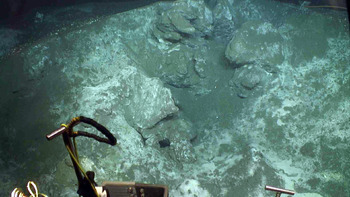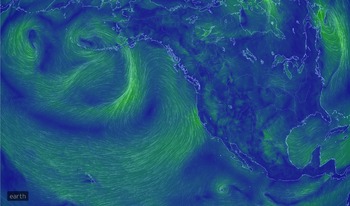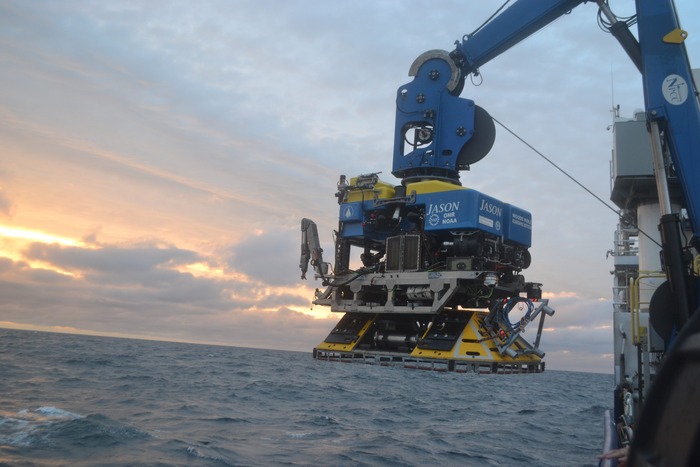We are all excited to see if the very rare “weird” fish makes its annual appearance at Slope Base

Einsteins' Grotto, the active methane seep first visited by the UW in 2010, continues to surprise us - this year, multiple bubble streams were issuing from the pit and exposed methane hydrate was documented in the sides of the wall. Credit: UW/NSF-OOI/WHOI, V18.

A weather disturbance in the Gulf of Alaska June 25, 2018, is sending large swells into our work area that prevents diving with heavy packages. This screen grab is from the https://earth.nullschool.net/ site, which we frequently use to get an overview of conditions across the Pacific and more locally. The one shown here is of winds.
Since we left port on June 23, the days have flown by. We have been incredibly busy completing Jason Dives 1043-1049. Many of the Cabled Array team has been working 18-20 hr days (catching sleep when they can) to get as much infrastructure into the ocean and back before weather comes in tomorrow and through part of Wednesday. Everybody has pitched in with hard work, but there is also much laughter, kidding, and happiness to be out here again.
During these first two days, we have completed turning (recovered and installed a refurbished platform/instrument) of the instrumented platforms on the Shallow Profiler Mooring at the Slope Base site, a low voltage junction box and digital still camera at the Oregon Offshore Site and installed a Benthic Experiment Platform there. On the transit to the methane seep site called Southern Hydrate Ridge, the hull mounted sonar on the R/V Revelle was used to image very strong bubble plumes issuing from the novel seep site called Pythias Oasis discovered a few years ago on the Cabled Array cruise and completed another time series survey of bubble plumes at Southern Hydrate Ridge. Here Jason installed a medium-powered junction box, and completed our annual survey of Einsteins’ Grotto – a phenomenally active seep site that in the past has had explosions of bubbles and sediments issuing from a large collapsed area.
The students onboard are some of the most excited and hard working we have had as participants in the VISIONS program and they already have made important contributions to the cruise. With the Cabled Array science and engineering teams working full out, the students have taken on important tasks of documenting Jason deployment and recovery dives, what infrastructure-instruments are going down on each dive, as well as taking images of the gear once it comes onboard.
Today, the Jason control van was filled with a bunch of excited, smiling faces as the students got to see for the first time methane seeps 2000 ft beneath the oceans surface and the incredible life that thrives in these extreme environments – soft corals, 10” long clams with hemoglobin, hag fish, crabs, and a variety of other fish. A special treat at Einsteins’ Grotto, was the discovery of methane hydrate (a lattice of ice that encases methane) exposed in the steep sided, rough walls of this deposit: we have never seen exposed hydrate here! Once again, this area has changed dramatically over the past year. There has been a vast expansion of white bacterial mats, the area is significantly more rugged with many new sites of “blow outs” caused by methane bubble emissions, and the seafloor is much more hummocky. To the north, we found a new small fissure system that has opened this past year, suggesting new sites of bubble plumes.
This evening, due to a large offshore disturbance in the Gulf of Alaska, the seas were marked by very large swells, causing the ship to roll, and roll from side to side during the Jason dive at Southern Hydrate Ridge. With heavy packages under the vehicle, the waves put a lot of tension on the fiber optic tether that supports the vehicle. To insure safe dive conditions for both the equipment and the team, the decision was made to transit ~ 1 hr to the west back to the Slope Base site to conduct a ‘naked’ dive with Jason. This means that the ROV will not take down a heavy package under the vehicle, but instead a CTD and oxygen sensor on the front porch of the vehicle. The dive is the deepest that will be conducted – 2900 m (9500 ft) – on this cruise. We are all excited to see if the “weird” fish makes its annual appearance. These ancient looking fish were first discovered in the waters off Antarctica, and were filmed for the first time on our Cabled Array VISIONS cruise in 2014 with the Canadian ROV ROPOS.


